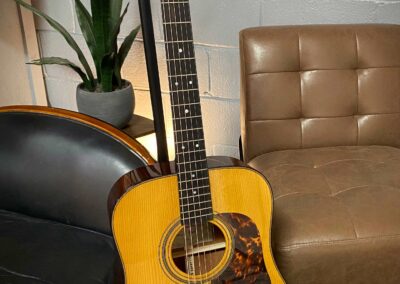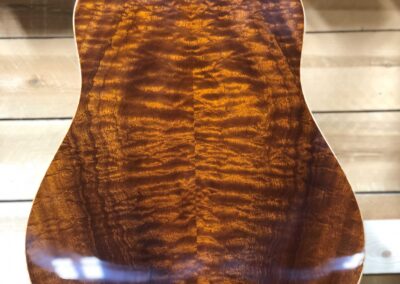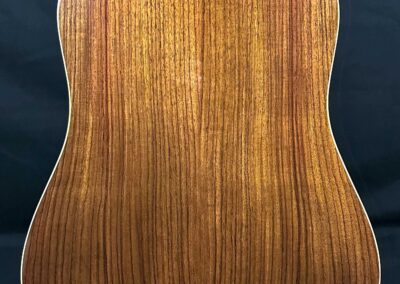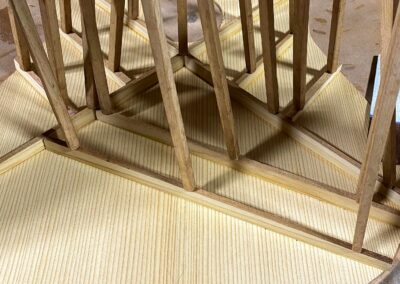The Gallagher Bluegrass Bell
“It rings like a bell.”
We are pleased to announce a new Gallagher model that is distinctly different from our previous offerings. The Bluegrass Bell harkens back to the prewar days of vintage guitars. We achieve that goal with forward shifted x-brace that was patterned after a 1937 D-18. We added torrefied Adirondack spruce top and bracing. In a departure from our headstock design, we incorporated our French curve with a square headstock.
Bluegrass Bell – Mahogany $4,900
- Mahogany back and sides
- Torrefied Adirondack spruce top
- Forward-shifted X-brace
- Herringbone trim and rosette
- Tortoise shell bound body
- 1 ¾” neck, joined at the 14th fret, MoP dots
- Square headstock with G and French curve wood inlay
- Open gear tuners
Bluegrass Bell – East Indian Rosewood $5,300
- Rosewood back and sides
- Torrefied Adirondack spruce top
- Forward-shifted X-brace
- Herringbone trim and rosette
- Ivoroid bound body
- 1 ¾” neck, joined at the 14th fret, MoP dots
- Square headstock with G and French curve wood inlay
- Open gear tuners
Bluegrass Bell – Madagascar Rosewood $5,900
- Madagascar back and sides
- Torrefied Adirondack spruce top
- Forward-shifted X-brace
- Herringbone trim and rosette
- Ivoroid bound body
- 1 ¾” neck, joined at the 14th fret, MoP dots
- Square headstock with G and French curve wood inlay
- Open gear tuners

Madagascar Rosewood has similar sonic and visual properties of Brazilian Rosewood. The tonal range is exceptional, with clear highs, resounding mid-range punch, and a rich and defined bass. This make Madagascar a favorite go-to substitute for Brazilian Rosewood.
If you’d like to learn more about this guitar, drop us an email at: GallagherGuitarCo@gmail.com
The forward-shifted X-brace to the positioning of the X-shaped brace, which is moved closer to the soundhole than in a traditional X-brace pattern. This design has several effects on the tone, projection, and responsiveness of the guitar. It allows for a larger, more flexible surface area behind the bridge, which can result in an increased bass response. This can give the guitar a fuller, warmer sound, particularly in the lower frequency range. The forward-shifted X-brace can make the guitar more responsive to different playing styles and techniques. The increased flexibility of the top can produce a more dynamic range, with the guitar reacting more quickly to variations in picking and strumming
Torrefied tonewood is wood that has undergone a specific heat treatment process called “torrefaction” to improve its properties for use in musical instruments. The torrefaction process involves heating the wood in a controlled environment with little to no oxygen, typically at temperatures between 200-320°C (392-608°F) for a certain period of time.
Torrefaction removes moisture and volatile organic compounds from the wood, making it more resistant to changes in temperature and humidity. It also simulates the natural aging process of wood, providing a more mature and resonant tone similar to that of vintage instruments. This can be particularly appealing to musicians looking for a seasoned sound without having to wait decades for their instruments to age naturally. Torrefaction can reduce the weight of the wood while maintaining its structural integrity. This can result in lighter, more comfortable instruments without compromising sound quality or durability.












